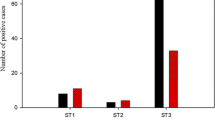Abstract
Blastocystis hominis (B. hominis) is a protozoan zoonosis which clinical signs of infection with this parasite has been reported to be more severe in patients with weakened immune systems than healthy controls. So, the aim of the study was to evaluate genomic analysis of B. hominis isolates obtained from patients with HIV-positive using locus SSU-rDNA. At first, 268 stool samples were randomly collected from patients with HIV-positive referred to health centers of Khuzestan province, southwest of Iran. Formol-ether and direct smear techniques were used for the detection of parasitic agents. After extracting DNA, the samples were analyzed by the PCR method. Finally, the subtypes were determined by the sequencing and PCR methods. New samples were used for the preparation of positive control sample; they were cultured in coagulant-serum biphasic cultivation media. Of 268 stool samples, 33 (12.3%) cases were detected positive for B. hominis using Formol-Ether technique but 51 (19%) cases were positive using molecular method. The most common isolates were related to the subtype III with 29 positive cases (56.8%), then, genotype I with 11 (21.6%) cases, 6 cases (11.8%) with genotype II, 3 (5.9%) combined cases with genotypes I and III as well as 2 cases (3.9%) with genotype VI. There was a significant difference between two groups of HIV-positive patients (infected with the parasite and/or without the parasite) in the term of the mean of TCD4-positive cells. The results indicated a relatively high prevalence of B. hominis in HIV-positive patients as well as our findings may represent that the number reduction of TCD4-positive cells has an effective role in the increased risk of the parasitic infection in HIV-positive patients.



Similar content being viewed by others
References
Badparva E, Sadraee J, Kheirandish F (2015) Genetic diversity of blastocystis isolated from cattle in Khorramabad, Iran. Jundishapur J Microbiol 8(3):e14810
Cirioni O, Giacometti A, Drenaggi D, Ancarani F, Scalise G (1999) Prevalence and clinical relevance of Blastocystis hominis in diverse patient cohorts. Eur J Epidemiol 15(4):387–391
Domínguez-Márquez MV, Guna R, Muñoz C, Gómez-Muñoz MT, Borrás R (2009) High prevalence of subtype 4 among isolates of Blastocystis hominis from symptomatic patients of a health district of Valencia (Spain). Parasitol Res 105(4):949–955
Eroglu F, Genc A, Elgun G, Koltas IS (2009) Identification of Blastocystis hominis isolates from asymptomatic and symptomatic patients by PCR. Parasitol Res 105(6):1589–1592
Fariba B et al (2010) A study of the prevalence of intestinal parasitic infection in HIV positive individuals in Mashhad, Northeast Iran. Jundishapur J Microbiol 2010(2, Spring):61–65
Graczyk TK, Shiff CK, Tamang L, Munsaka F, Beitin AM, Moss WJ (2005) The association of Blastocystis hominis and Endolimax nana with diarrheal stools in Zambian school-age children. Parasitol Res 98(1):38–43
Guignard S, Arienti H, Freyre L, Lujan H, Rubinstein H (2000) Prevalence of enteroparasites in a residence for children in the Cordoba Province, Argentina. Eur J Epidemiol 16(3):287–293
Hellard ME, Sinclair MI, Hogg GG, Fairley CK (2000) Prevalence of enteric pathogens among community based asymptomatic individuals. J Gastroenterol Hepatol 15(3):290–293
John DT, Petri WA, Markell EK, Voge M (2006) Markell and Voge’s medical parasitology. Elsevier Health Sciences, Amsterdam
Jones MS, Whipps CM, Ganac RD, Hudson NR, Boroom K (2009) Association of Blastocystis subtype 3 and 1 with patients from an Oregon community presenting with chronic gastrointestinal illness. Parasitol Res 104(2):341–345
Moosavi A et al (2012) Genetic variability of Blastocystis sp. isolated from symptomatic and asymptomatic individuals in Iran. Parasitol Res 111(6):2311–2315
Motazedian H, Ghasemi H, Sadjjadi S (2008) Genomic diversity of Blastocystis hominis from patients in southern Iran. Ann Trop Med Parasitol 102(1):85–88
Parkar U et al (2010) Molecular characterization of Blastocystis isolates from zoo animals and their animal-keepers. Vet Parasitol 169(1):8–17
Poirier P, Wawrzyniak I, Albert A, El Alaoui H, Delbac F, Livrelli V (2011) Development and evaluation of a real-time PCR assay for detection and quantification of Blastocystis parasites in human stool samples: prospective study of patients with hematological malignancies. J Clin Microbiol 49(3):975–983
Safi M, Tavalla M, Mardani M, Afrisham R (2016) Prevalence of intestinal parasitic infections among applicants for health cards attending Ahvaz East Health Center during 2012–2013. Asian Pac J Trop Dis 6(2):151–154
Stensvold CR et al (2007) Terminology for Blastocystis subtypes—a consensus. Trends Parasitol 23(3):93–96
Stensvold CR et al (2009a) Subtype distribution of Blastocystis isolates from synanthropic and zoo animals and identification of a new subtype. Int J Parasitol 39(4):473–479
Stensvold CR, Lewis H, Hammerum AM, Porsbo LJ, Nielsen SS, Olsen KE, Arendrup MC, Nielsen HV, Mølbak K (2009b) Blastocystis: unravelling potential risk factors and clinical significance of a common but neglected parasite. Epidemiol Infect 137:1655–1663
Tan T, Suresh K, Smith H (2008) Phenotypic and genotypic characterisation of Blastocystis hominis isolates implicates subtype 3 as a subtype with pathogenic potential. Parasitol Res 104(1):85–93
Tan T, Ong S, Suresh K (2009) Genetic variability of Blastocystis sp. isolates obtained from cancer and HIV/AIDS patients. Parasitol Res 105(5):1283–1286
Yoshikawa H et al (2000) Genomic analysis of Blastocystis hominis Strains isolated from two long-term health care facilities. J Clin Microbiol 38(4):1324–1330
Zali MR, Mehr AJ, Rezaian M, Meamar AR, Vaziri S, Mohraz M (2004) Prevalence of intestinal parasitic pathogens among HIV-positive individuals in Iran. Jpn J Infect Dis 57(6):268–270
Zhang X, Qiao J, Wu X, Da R, Zhao L, Wei Z (2012) In vitro culture of Blastocystis hominis in three liquid media and its usefulness in the diagnosis of blastocystosis. Int J Infect Dis 16(1):e23–e28
Acknowledgments
This article is the result of a research project with number OG-93112 approved by the Ahvaz Jundishapur University of Medical Sciences, Iran. The authors thank the esteemed group of Parasitology and Research Center of Tropical Infectious Diseases.
Author information
Authors and Affiliations
Contributions
All authors contributed to the study design. MT and SK were leader of the research. ARP carried out experimental tests and prepared the Manuscript. All authors read and approved the final version of the manuscript.
Corresponding author
Ethics declarations
Conflict of interest
The authors declare that they have no competing interests
Ethical standard
All experimental procedures were approved by the Ethics Committee of Ahvaz Jundishapur University of Medical Sciences, Iran.
Informed consent
Informed consent was obtained from subjects involved in this study.
Rights and permissions
About this article
Cite this article
Piranshahi, A.R., Tavalla, M. & Khademvatan, S. Genomic analysis of Blastocystis hominis isolates in patients with HIV-positive using locus SSU-rDNA. J Parasit Dis 42, 28–33 (2018). https://doi.org/10.1007/s12639-017-0957-8
Received:
Accepted:
Published:
Issue Date:
DOI: https://doi.org/10.1007/s12639-017-0957-8




